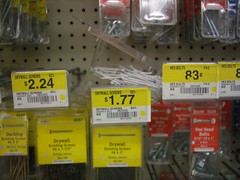A wise man once told me that retail is billions of pennies. He was my boss's boss, and it was my first day on the job. Needless to say, I was confused. I pictured giant warehouses of pennies, stores overflowing with pennies, people pushing shopping carts through oceans of pennies. What the hell was this guy talking about?
Well, I think I get it now. Retail, at least the mass market kind, is about low margins and high scale. Let me explain.
Let's say Wal*Mart sells a hammer for $5.00. Millions of people walk past it, all over the country and all over the world. Of those millions who walk past the hammer, only thousands see it. Of those thousands who see it, only one thousand decide to buy it.
But those thousand people are hardly insignificant. If a thousand people buy a $5.00 hammer, that's a sizable chunk of change. However, let's say Wal*Mart paid the hammer maker $4.78 apiece. So they only make 12 cents on each hammer sold. Hence, they need to sell a lot.
Now let's say Wal*Mart notices that the hammer is selling well, so they raise the price to $5.05. Five more pennies. Not a big difference to a shopper, but that's 17 cents of margin instead of 12. An extra $500 for the store, just like that.
This type of scale is what allows stores to stay in business with twelve-cent margins. If you picture your shopping cart from the store's perspective, they are getting 50 cents on your soap, 13 cents on your apples, 24 cents on your deodorant, and so on. If 600 people buy that deodorant, the pennies add up.
And what we don't think about is that stores are measuring our every move. If you are in CVS and you see a slick new display, some part of your brain says "Ooh, this Dove body lotion looks great!" and you buy one. Did your single purchase make a difference to CVS? Hardly. But you are just one of many. That display caused 20 extra people to buy Dove body lotion in that store. It caused 2,000 extra people to buy Dove body lotion in all stores. CVS made a bunch of pennies off that one.
Our actions at retail are measured with a giant lens. Each time we add one more item to our cart, the store doesn't earn that much - maybe a few cents, maybe a dollar. But with massive scale, our collective actions add up. It's kinda like voting.
I only recently realized the true meaning of the comment, after spending a significant amount of time inside Wal*Mart. They've tinkered with every last price tag, so that instead of a whole shelf of product being $1.99, some items are $1.77 while others are $2.24. Because they are so large, every last cent makes a difference.
Retail is big business, that's for sure. But it isn't always about millions of dollars. Sometimes, it's about billions of pennies.
Subscribe to:
Post Comments (Atom)


2 comments:
interesting abstraction. It made me think that if a few cents added to a product make little difference tot he consumer and a lot of difference to the store, then what would happen if Wal*Mart raised the price of every product by 0.01 cents? Would it work? or would customers notice like george mentioned?
Wal*Mart has historically used a "mark it up 30% and sell the hell out of it" pricing policy. In his book "Made in America" Sam Walton talks about how, in the early days, they'd get a great deal on Moon Pies or somesuch and the managers would be all over him to squeak out more margin by keeping the price the same. Sam would not have any of it, ordering them to "mark it up 30% and sell the hell out of it."
Not sure if this practice is still in vogue in Bentonville these days, but seems logical as to how an item could end up at $2.24.
It is a very good book, whatever you feel about Wal*Mart of the 21st century.
**Note: Sara, your hammer example has a slight error. If the hammer were $5.05 and they sold 1,000 of them, the store would enjoy $50 of extra booty, not $500.
Post a Comment